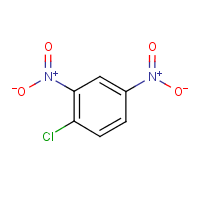1-Chloro-2,4-dinitrobenzene
Agent Name
1-Chloro-2,4-dinitrobenzene
Alternative Name
Dinitrochlorobenzene
CAS Number
97-00-7
Formula
C6-H3-Cl-N2-O4
Major Category
Nitrogen Compounds

Synonyms
Dinitrochlorobenzene; 1,3-Dinitro-4-chlorobenzene; 1-Chloor-2,4-dinitrobenzeen [Dutch]; 1-Chlor-2,4-dinitrobenzene; 1-Chlor-2,4-dinitrobenzol; 1-Chloro-2,4-dinitrobenzeen [Dutch]; 1-Chloro-2,4-dinitrobenzol [German]; 1-Cloro-2,4-dinitrobenzene [Italian]; 2,4-Dinitro-1-chlorobenzene; 2,4-Dinitrochlorobenzene; 2,4-Dinitrophenyl chloride; 4-Chloro-1,3-dinitrobenzene; 6-Chloro-1,3-dinitrobenzene; Benzene, 1-chloro-2,4-dinitro-; CDNB; Chlorodinitrobenzene; DNCB; Dinitrochlorobenzene (VAN); Dinitrochlorobenzol; [ChemIDplus] UN1577
Category
Nitros, Aromatic
Description
Yellow solid with an almond odor; [HSDB] Crystalline powder; [MSDSonline]
Sources/Uses
Used as a reagent for the detection and determination of pyridine compounds; in the manufacture of azo dyes; as an algicide in coolant water; as an immunostimulant in leprosy and some forms of cancer; and in the treatment of alopecia and warts; [HSDB]
Comments
Emergency treatment: Methemoglobinemia; May cause retrobulbar neuritis and loss of vision after chronic exposure; [HSDB] May cause allergic dermatitis; [Merck Index] A skin, eye, and respiratory tract irritant; May cause skin sensitization; Can induce methemoglobinemia; May cause nervous system injury resulting in impaired vision; [ICSC] Toxic by inhalation, ingestion, and skin absorption; [CAMEO] Dinitrochlorobenzene (DNCB) is a potent contact allergen that has been used in the treatment of alopecia areata and cutaneous metastasis of malignant melanoma; [Kanerva, p. 1787] An irritant; May cause skin sensitization; Effects in high-dose animal studies include methemoglobinemia, carboxyhemoglobin, convulsions or effect on seizure threshold, and other degenerative changes to brain; [MSDSonline]
Biomedical References
Exposure Assessment
Vapor Pressure
8.5E-05 mm Hg
Explanatory Notes
Flash point = 179 deg C; [ICSC]
NFPA
must be preheated
Adverse Effects
Skin Sensitizer
Yes
Methemoglobinemia
MetHgb is secondary toxic effect
Neurotoxin
Other CNS neurotoxin
Diseases, Processes, and Activities Linked to This Agent
Diseases
Occupational diseases associated with exposure to this agent: